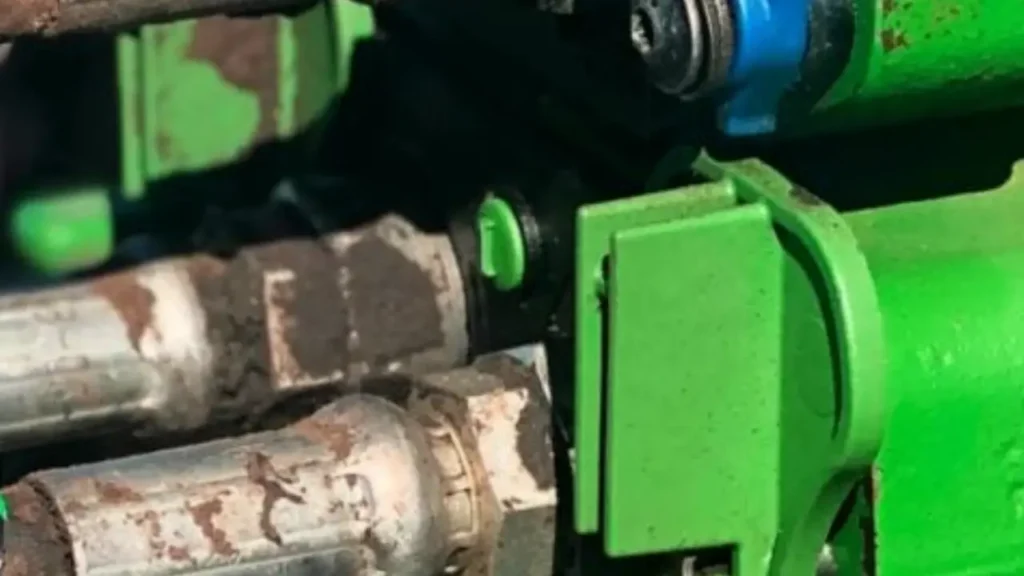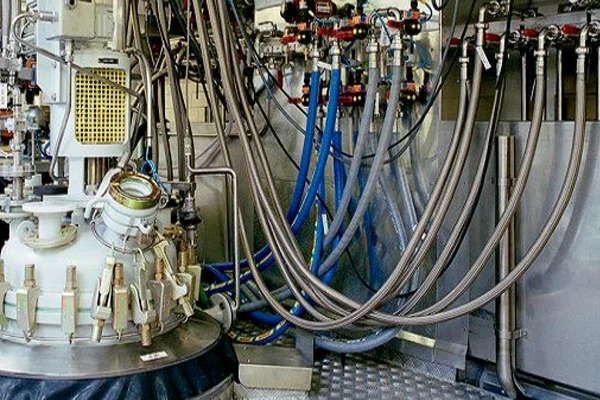Dealing with a hydraulic hose leaking at the fitting can be a frustrating issue that needs to be addressed promptly. A leaking fitting can result in fluid loss, reduced system performance, and potential safety hazards.
We will provide expert tips and step-by-step instructions to help you effectively fix hydraulic hose leaks at fittings, ensuring a reliable and leak-free hydraulic system.
Identify the Source of the Hydraulic Hose Leak

When a hydraulic hose is leaking, it means that there is an undesired loss of hydraulic fluid from the system. Leaks can occur at various points along the hose, including the fittings, connections, or even the hose itself. It is crucial to address hydraulic hose leaks promptly, as they can lead to decreased system performance, increased fluid consumption, environmental concerns, and potential safety hazards. Here are some common causes and factors related to hydraulic hose leaks:
- Wear and Tear: Over time, hydraulic hoses can experience wear and tear due to factors such as constant movement, exposure to extreme temperatures, friction, and pressure. This wear can weaken the hose material, making it more susceptible to leaks.
- Improper Installation: Incorrect installation techniques or the use of incompatible fittings can lead to leaks. Inadequate tightening, incorrect assembly, or improper crimping can result in gaps or loose connections that allow fluid to escape.
- High Pressure: Excessive pressure within the hydraulic system can cause hoses to develop leaks. This can occur due to factors like system malfunctions, overloading, or exceeding the recommended operating pressure limits of the hose.
- Abrasion and Physical Damage: Hoses that come into contact with sharp edges, abrasive surfaces, or other machinery components can suffer from abrasion and physical damage. This can cause the outer layer of the hose to wear down, exposing the inner layers and leading to leaks.
- Age and Degradation: Hydraulic hoses have a limited lifespan and can degrade over time. Exposure to UV radiation, chemicals, and harsh environmental conditions can cause the hose material to deteriorate, resulting in cracks, degradation, or leaks.
- Improper Maintenance: Inadequate maintenance practices, such as neglecting regular inspections, failing to replace worn-out components, or using expired hoses, can contribute to hydraulic hose leaks.
When a hydraulic hose is leaking, it is important to identify the source of the leak, assess the extent of the damage, and take appropriate actions to repair or replace the affected components. Promptly addressing leaks, whether by tightening fittings, replacing damaged hoses, or seeking professional assistance, is crucial to maintaining the integrity and performance of the hydraulic system. Regular maintenance, inspections, and adherence to manufacturer guidelines can help prevent and detect hydraulic hose leaks before they become significant issues.
How Do You Stop a Hydraulic Fitting From Leaking?
Stopping a hydraulic fitting from leaking is crucial for system efficiency and safety. Leaks not only waste fluid but can also lead to contamination, reduced performance, and even environmental hazards. Addressing leaks promptly can prevent minor issues from escalating into major problems, ensuring your hydraulic system operates smoothly and reliably.
Identify the Source of the Leak
The first and most critical step is to accurately pinpoint where the leak is originating. This might seem obvious, but fluid can travel along lines and components, making the actual source tricky to find. Carefully inspect all connections, hoses, and seals. Look for drips, wet spots, or even signs of weeping around the fitting itself. Sometimes, running a clean cloth along the connection can help reveal the exact point where fluid is escaping.
Relieve System Pressure
Before attempting any work on hydraulic fittings, it is absolutely imperative to depressurize the system. Working on a pressurized hydraulic system is extremely dangerous and can lead to serious injury or death due to high-pressure fluid injection. Consult your equipment’s manual for the specific procedure to safely relieve hydraulic pressure, which typically involves shutting down the pump, cycling control valves, and potentially opening bleeder valves.
Clean the Area Thoroughly
Once the system is depressurized, thoroughly clean the area around the leaking fitting. Remove any old hydraulic fluid, dirt, grime, and debris. A clean working area allows for better visibility during the repair process and prevents contaminants from entering the hydraulic system. Use a clean rag and a suitable degreaser if necessary, ensuring no residue is left behind that could interfere with the seal.
Inspect the Fitting and Sealing Surfaces
With the area clean, meticulously inspect the fitting components for any signs of damage. Look for cracks, corrosion, stripping of threads, or deformities on the nut, body, and especially the sealing surfaces. Check the condition of any O-rings, gaskets, or metal-to-metal flare seats. Even a minor scratch or imperfection on these surfaces can compromise the seal and lead to a leak. If any damage is found, the component likely needs replacement.
Tighten or Replace the Fitting
If the fitting and sealing surfaces appear to be in good condition, the leak might simply be due to insufficient tightening. Carefully tighten the fitting to the manufacturer’s recommended torque specifications. Avoid overtightening, as this can damage threads or deform sealing surfaces. If tightening does not stop the leak or if damage was identified, the fitting or its sealing components (like an O-ring or ferrule) must be replaced with a new, compatible part. Ensure you use the correct type and size of replacement.
Re-pressurize and Test
After addressing the fitting, slowly and carefully re-pressurize the hydraulic system according to the manufacturer’s instructions. Once the system is back to operating pressure, thoroughly check the repaired area for any signs of continued leakage. Monitor the fitting for a period of time, both static and during operation, to ensure the seal holds under working conditions. If a leak persists, repeat the troubleshooting steps.
Tighten Hydraulic Fittings
If the leak is caused by a loose fitting, use an appropriate wrench to tighten it securely. Ensure not to overtighten, as it can damage the hydraulic fittings or the hose. Check for leaks again after tightening. How to Tighten Hydraulic Hose Fittings?
Replace the O-Ring
If the leak persists, the O-ring may be damaged or worn out. Carefully remove the fitting and inspect the O-ring for cracks, tears, or deformation. Replace the O-ring with a new one of the correct size and material, ensuring a proper fit.
Reassemble the Fitting
Clean the fitting and the hose end thoroughly to remove any debris or old sealant. Apply a small amount of thread sealant or hydraulic-specific sealant to the threads, ensuring it is compatible with the hydraulic fluid. Reassemble the fitting, making sure it is tightened securely but not excessively.
Assess the Hose Condition
Inspect the hose for any signs of damage, such as cracks, bulges, or excessive wear near the fitting. If the hose is damaged, it is recommended to replace it entirely to prevent further leaks and ensure system integrity.
Regular Maintenance
To prevent future leaks, incorporate regular maintenance into your routine. Inspect hydraulic hoses and fittings periodically, checking for signs of wear, loose fittings, or potential issues. Promptly address any emerging problems to avoid major failures and costly repairs.
How to Seal a Leaky Hydraulic Fitting?

Even after identifying a leaky hydraulic fitting, the process of effectively sealing it requires specific steps and considerations. Proper sealing is paramount to prevent fluid loss, maintain system efficiency, and ensure operational safety. This guide outlines the key procedures to successfully seal a leaky hydraulic fitting, ensuring a lasting and reliable repair.
Prepare the Work Area and Depressurize the System
Before attempting any work, ensure the area around the leaky fitting is clean and free of debris. Use a rag and a suitable cleaner to remove any existing hydraulic fluid, dirt, or grease, which will help you better assess the leak and prevent contamination during the repair. Crucially, always relieve the hydraulic system’s pressure before loosening or tightening any fittings. Failure to do so can result in serious injury from high-pressure fluid injection. Consult your equipment’s manual for the safe depressurization procedure.
Inspect and Disassemble the Leaky Fitting
Once the system is depressurized and the area is clean, carefully inspect the leaking fitting and its connection point. Look for visible damage such as cracks, stripped threads, corrosion, or deformities on the fitting body, nut, and especially the sealing surfaces. If the fitting uses an O-ring or other soft seal, examine it for cuts, nicks, hardening, or flattening. Gently loosen and disassemble the fitting components as needed to get a clear view of all sealing surfaces.
Clean and Replace Damaged Components
Thoroughly clean all components of the fitting, including threads and sealing surfaces, using a clean rag and appropriate cleaning solution. This ensures no contaminants interfere with the new seal. If your inspection revealed any damaged parts—such as a compromised O-ring, a nicked flare, or stripped threads—these components must be replaced. Attempting to reuse damaged parts will almost certainly result in a persistent leak. Ensure replacement parts are of the correct type, size, and material for the specific hydraulic fluid and pressure rating.
Apply Appropriate Sealant or Lubricant (If Applicable)
For some fittings, a specific sealant or lubricant is recommended to aid in creating a secure seal. For example, pipe thread sealant (thread tape or pipe dope) is typically used on NPT (tapered) threads to fill voids and prevent spiraling leaks, as these threads seal by deformation. For O-ring seals, a light coating of hydraulic fluid or a compatible O-ring lubricant can help prevent twisting and pinching during assembly, ensuring the O-ring seats properly. Do not use thread sealant on parallel thread fittings that rely on O-rings or other soft seals, as it can interfere with the primary sealing mechanism.
Reassemble and Torque the Fitting Correctly
Carefully reassemble the fitting, ensuring all components are aligned correctly. Begin by hand-tightening the fitting to ensure threads engage properly and prevent cross-threading. Once hand-tight, use a wrench to tighten the fitting to the manufacturer’s specified torque recommendations. Over-tightening can deform sealing surfaces or strip threads, while under-tightening will lead to leaks. Using a torque wrench is highly recommended for critical applications to ensure precise tightening.
Re-pressurize and Test for Leaks
After the fitting is securely reassembled, slowly re-pressurize the hydraulic system following the proper procedure for your equipment. Once the system is back to operating pressure, visually inspect the repaired fitting for any signs of leakage. It’s often beneficial to cycle the hydraulic functions or operate the equipment briefly to put the fitting under working conditions and confirm the seal holds under dynamic pressure. Continue to monitor the connection for a short period to ensure the leak has been permanently resolved.
Conclusion:
Fixing a hydraulic hose leaking at the fitting requires attention to detail and proper techniques. By following these expert tips and step-by-step instructions, you can effectively repair the leak and restore the integrity of your hydraulic system. Remember to prioritize safety, conduct regular inspections, and seek professional assistance when needed. With proactive maintenance and prompt repairs, you can ensure a reliable and leak-free hydraulic system for optimal performance.




